Human Orbital Spaceflights
![]()
International Flight No. 69Soyuz 35Soyuz 37DneprUSSR |
![]()
Launch, orbit and landing data
walkout photo |
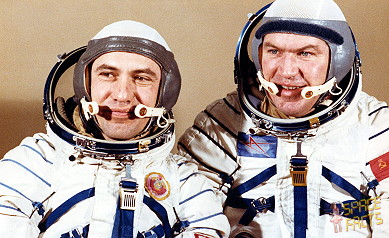 |
|||||||||||||||||||||||||||||||
alternative crew photo |
alternative crew photo |
|||||||||||||||||||||||||||||||
alternative crew photo |
alternative crew photo |
|||||||||||||||||||||||||||||||
original crew photo |
alternative crew photo |
|||||||||||||||||||||||||||||||
Crew
| No. | Surname | Given names | Position | Flight No. | Duration | Orbits | |
| 1 | Popov | Leonid Ivanovich | Commander | 1 | 184d 20h 11m 35s | 2917 | |
| 2 | Ryumin | Valeri Viktorovich | Flight Engineer | 3 | 184d 20h 11m 35s | 2917 |
Crew seating arrangement
|
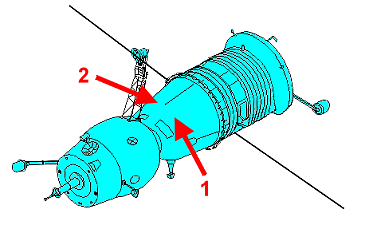 |
|
||||||||||||
Backup Crew
|
 |
|||||||||||||||
alternative crew photo |
Hardware
| Launch vehicle: | Soyuz-U (No. Zh15000-189) |
| Spacecraft: | Soyuz 35 (7K-T No. 51) |
Flight
|
Launch from the Baikonur Cosmodrome and
landing with Soyuz 37 capsule 180 km
southeast of Dzheskasgan. Valentin Lebedev was scheduled to be Leonid Popov's Flight Engineer, but he required an operation after injuring his knee while working out on a trampoline. Valeri Ryumin, of the last crew to visit Salyut 6, was called in to fill his place. Following a one-day solo flight Soyuz 35 docked with Salyut 6 on April 10, 1980. The cosmonauts became the fourth resident crew. The space station was in good, but not in perfect shape, when the crew arrived. Upon entering Salyut 6, Valeri Ryumin noted that the two viewports in the transfer compartment had lost their transparency. The windows also had many chips in them caused by micrometeoroids and orbital debris. The cosmonauts had a rather busy time onboard the station. They replaced components of the attitude control system and life support system, installed a new caution and warning system, synchronized the station's clocks with those in the TsUP, added an 80 kg storage battery, and replaced air from tanks in Progress 8. By April 15, 1980, the Progress tanker had been emptied of supplies, and the crew filled it with garbage and deorbited the craft April 25, 1980. Two days later, Progress 9 was launched, docking with the facility on April 29, 1980. The next day, the first-ever transfer of water between a tanker and a Salyut station was completed. Cargo transfers and refueling operations were completed by May 12, 1980. With this flight, the resupply of the Salyut was complete for the long-duration crew. Several scientific experiments were performed as biological cultivation tests, photography of the Earth surface, materials science Kristall or Splav-01 materials processing furnaces. Minor repair work was carried out by the crew and "Lotos" was carried out, an experiment involving using special moulds to make plastic items with a quick-setting material. Additional experiments involved production of polyurethane foam, exploring its utility in assembling structures in orbit. Progress 9 was undocked May 20, 1980, leaving the rear port vacant for the arrival of the next crew. Soyuz 36 was launched May 26, 1980. Valeri Kubasov and Bertalan Farkas swapped Soyuz craft with the long-duration crew, departing the station in Soyuz 35 on June 03, 1980. The next day, Leonid Popov and Valeri Ryumin entered Soyuz 36, undocked it from the station, then redocked it 90 minutes later at the vacant front dock. The rapid switch of ferry vehicles, along with the launch of Soyuz 36 at almost the earliest possible date to allow a crew recovery in the nominal window, caused observers to speculate the secretive Soviets were possibly planning a second Intercosmos mission to recoup the time lost after the Soyuz 33 failure. A launch indeed was soon in the offing, but not the predicted mission. Soyuz T-2 was launched June 05, 1980 with Yuri Malyshev and Vladimir Aksyonov on what turned out to be the first manned mission of the new Soyuz T variant. The craft docked at Salyut 6's rear port the next day. The mission proved to be a short one, as they undocked in the craft they arrived on only two days after first greeting the resident crew. The fourth resident crew returned to their routine. Leonid Popov and Valeri Ryumin relied heavily on the running track and bicycle ergometer to maintain their fitness so they could return safely to Earth after their prolonged stay in weightlessness. On June 15, 1980 their running track broke, but the cosmonauts avoided repairing it for several days, because 'it meant unscrewing a lot of bolts and would take a lot of time to repair.' However, doctors on the ground ordered them to increase their level of exercise, so they had to repair the track. Also, at about this time, the cosmonauts repaired the Kaskad attitude control system, in the process expending a large amount of fuel. The fourth resident crew carried out repairs of the station's Kaskad attitude control system and performed materials processing experiments. On July 01, 1980, Leonid Popov and Valeri Ryumin received Progress 10 at the station. Replacement equipment was unloaded from the supply tanker, as were regular crew supplies. Supplies included a Polaroid camera, a color television monitor, and tapes of Soviet pop music. The tanker was undocked from the complex on July 17, 1980 after refueling the station and deorbited July 19, 1980. Also, on July 19, 1980, Leonid Popov and Valeri Ryumin sent their greetings from the station to the 1980 Summer Olympics, wishing the athletes happy starts in a live communication between the station and the Central Lenin Stadium where the opening ceremony was held. They appeared on the stadium's scoreboard and their voices were translated via loud speakers. From July 24, 1980 - July 31, 1980 Viktor Gorbatko and Pham Tuân of Vietnam visited the station, arriving in Soyuz 37, and returned to Earth in Soyuz 36. Pham Tuân's experiments involved observing Vietnam from space, life sciences (including tests of growth of Vietnamese azolla water ferns, with application to future closed-loop life support systems), and materials processing. After the crew had departed, on August 01, 1980, Soyuz 37 was repositioned by rotating Salyut 6, freeing the aft port for Soyuz 38. From September 19, 1980 - September 26, 1980 an international crew again visited the station. The Soyuz 38 docking occurred in darkness. As the spacecraft approached Salyut 6, the station crew could see only its 'headlights.' Valeri Ryumin filmed ignition and operation of the transport's main engine. Arnaldo Tamayo Méndez of Cuba and Soviet cosmonaut Yuri Romanenko docked without incident. Twenty-seven material processing and medical experiments were carried out by the visiting crew. As the Soyuz 35 crew was returning to Earth soon, the Soyuz 38 crew didn't swap their craft when they returned on September 26, 1980. The launch, therefore, of Progress 11 on September 28, 1980 came as surprise to observers, as it was assumed cosmonauts due to return to Earth would not need fresh supplies. Indeed, by the time the Soyuz 35 crew returned on October 11, 1980, the Progress was only partially unloaded. The Soyuz spacecraft is composed of three elements attached end-to-end - the Orbital Module, the Descent Module and the Instrumentation/Propulsion Module. The crew occupied the central element, the Descent Module. The other two modules are jettisoned prior to re-entry. They burn up in the atmosphere, so only the Descent Module returned to Earth. The deorbit burn lasted 188 seconds. Having shed two-thirds of its mass, the Soyuz reached Entry Interface - a point 400,000 feet (121.9 kilometers) above the Earth, where friction due to the thickening atmosphere began to heat its outer surfaces. With only 23 minutes left before it lands on the grassy plains of central Asia, attention in the module turned to slowing its rate of descent. Eight minutes later, the spacecraft was streaking through the sky at a rate of 755 feet (230 meters) per second. Before it touched down, its speed slowed to only 5 feet (1.5 meter) per second, and it lands at an even lower speed than that. Several onboard features ensure that the vehicle and crew land safely and in relative comfort. Four parachutes, deployed 15 minutes before landing, dramatically slowed the vehicle's rate of descent. Two pilot parachutes were the first to be released, and a drogue chute attached to the second one followed immediately after. The drogue, measuring 24 square meters (258 square feet) in area, slowed the rate of descent from 755 feet (230 meters) per second to 262 feet (80 meters) per second. The main parachute was the last to emerge. It is the largest chute, with a surface area of 10,764 square feet (1,000 square meters). Its harnesses shifted the vehicle's attitude to a 30-degree angle relative to the ground, dissipating heat, and then shifted it again to a straight vertical descent prior to landing. The main chute slowed the Soyuz to a descent rate of only 24 feet (7.3 meters) per second, which is still too fast for a comfortable landing. One second before touchdown, two sets of three small engines on the bottom of the vehicle fired, slowing the vehicle to soften the landing. The crew set a new spaceflight record. |
Photos / Graphics
 |
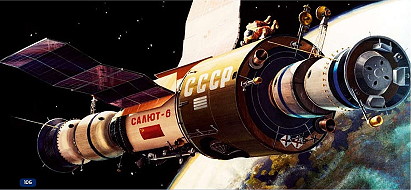 |
 |
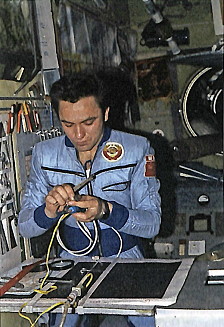 |
 |
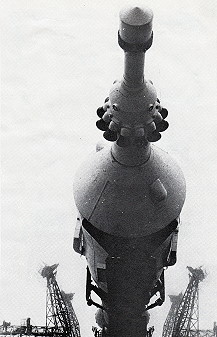 |
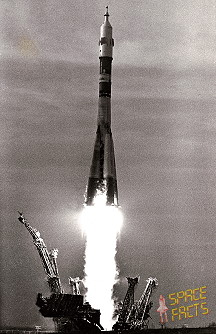 |
 |
 |
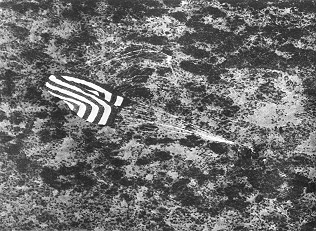 |
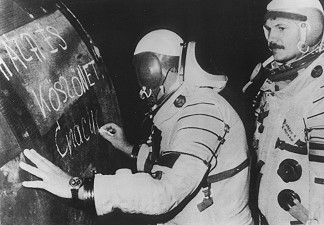 |
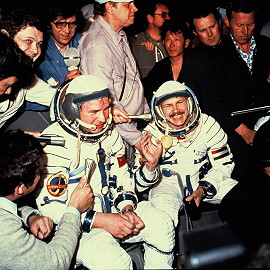 |
| © |  |
Last update on March 28, 2025.  |
 |